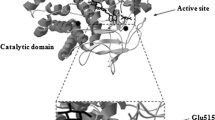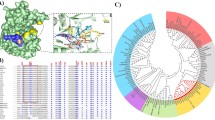Abstract
C-Terminal truncation mutagenesis was used to explore the functional and structural significance of the C-terminal region of Aeromonas caviae D1 chitinase (AcD1ChiA). Comparative studies between the engineered full-length AcD1ChiA and the truncated mutant (AcD1ChiAK606) included initial rate kinetics, fluorescence and circular dichroism (CD) spectrometric properties, and substrate binding and hydrolysis abilities. The overall catalytic efficiency, k cat/K M, of AcD1ChiAK606 with the 4MU-(GlcNAc)2 and the 4MU-(GlcNAc)3 chitin substrates was 15–26% decreased. When compared with AcD1ChiA, the truncated mutant AcD1ChiAK606 maintained 80% relative substrate-binding ability and about 76% of the hydrolyzing efficiency against the insoluble α-chitin substrate. Both fluorescence and CD spectroscopy indicated that AcD1ChiAK606 retained the same conformation as AcD1ChiA. These results indicated that removal of the C-terminal 259 amino acid residues, including the putative chitin-binding motif and the A region (a motif of unknown function) of AcD1ChiA, did not seriously affect the enzyme structure integrity as well as activity. The present study provided evidences illustrating that the binding and hydrolyzing of insoluble chitin substrates by AcD1ChiA were not absolutely dependent on the putative C-terminal chitin-binding domain and the function-unknown A region.






Similar content being viewed by others
References
Ausubel FM, Brent R, Kingston RE, Moore DD, Seidman JG, Smith JA, Struhl K (1993) Current protocols in molecular biology. Greene & Wiley-Interscience, New York
Blaak H, Schrempf H (1995) Binding and substrate specificities of a Streptomyces olivaceoviridis chitinase in comparison with its proteolytically processed form. Eur J Biochem 229:132–139
Bradford M (1976) A rapid and sensitive method for the quantitation of microgram quantities of protein utilizing the principle of protein-dye binding. Anal Biochem 72:248–254
Chang MC, Lai PL, Wu ML (2004) Biochemical characterization and site-directed mutational analysis of the double chitin-binding domain from chitinase 92 of Aeromonas hydrophila JP101. FEMS Microbiol Lett 232:61–66
Chen HC, Chen KS (1991) Isolation of chitinolytic bacteria and their hydrolytic activity on Shrimp shells. Proc Natl Sci Council ROC B Life Sci 15:233–239
Chuang HH, Lin FP (2007) New role of C-terminal 30 amino acids on the insoluble chitin hydrolysis in actively engineered chitinase from Vibrio parahaemolyticus. Appl Microbiol Biotechnol 76:123–133
Chuang HH, Lin HY, Lin FP (2008) Biochemical characteristics of C-terminal region of recombinant chitinase from Bacillus licheniformis—implication of necessity for enzyme properties. FEBS J 275:2240–2254
Erra-Pujada M, Chang-Pi-Hin F, Debeire P, Duchiron F, O’Donohue MJ (2001) Purification and properties of the catalytic domain of the thermostable pullulanase type II from Thermococcus hydrothermalis. Biotechnol Lett 23:1273–1277
Hashimoto M, Ikegami T, Seino S, Ohuchi N, Fukada H, Sugiyama J, Shirakawa M, Watanabe T (2000) Expression and characterization of the chitin-binding domain of chitinase A1 from Bacillus circulans WL-12. J Bacteriol 182:3045–3054
Henrissat B (1999) Classification of chitinases modules. EXS 87:137–156
Hirono I, Yamashita M, Aoki T (1998) Molecular cloning of chitinase genes from Vibrio anguillarum and V. parahaemolyticus. J Appl Microbiol 84:1175–1178
Itoi S, Kanomata Y, Koyama Y, Kadokura K, Uchida S, Nishio T, Oku T, Sugita H (2007) Identification of a novel endochitinase from a marine bacterium Vibrio proteolyticus strain no. 442. Biochim Biophys Acta 9:1099–1107
Kamei K, Yamamura Y, Hara S, Ikenaka T (1989) Amino acid sequence of chitinase from Streptomces erythraeus. J Biochem 105:979–985
Kezuka Y, Ohishi M, Itoh Y, Watanabe J, Mitsutomi M, Watanabe T, Nonaka T (2006) Structural studies of a two-domain chitinase from Streptomyces griseus HUT6037. J Mol Biol 358:472–484
Kojima M, Yoshikawa T, Ueda M, Nonomura T, Matsuda Y, Toyoda H, Miyatake K, Arai M, Fukamizo T (2005) Family 19 chitinase from Aeromonas sp. no. 10S-24: role of chitin-binding domain in the enzymatic activity. J Biochem 137:235–242
Kuranda MJ, Robbins PW (1991) Chitinase is required for cell separation during growth of Saccharomyces cerevisiae. J Biol Chem 266:19758–19767
Laemmli UK (1970) Cleavage of structural proteins during the assembly of the head of bacteriophage T4. Nature 227:680–685
Li Q, Wang F, Zhou Y, Xiao X (2005) Putative exposed aromatic and hydroxyl residues on the surface of the N-terminal domains of Chi1 from Aeromonas caviae CB101 are essential for chitin binding and hydrolysis. Appl Environ Microbiol 71:7559–7561
Lin CS, Chen HC, Lin FP (1997) Expression and characterization of the recombinant gene encoding chitinase from Aeromonas caviae. Enzyme Microb Technol 21:472–478
Lin FP, Juang WY, Chang KH, Chen HC (2001) G561 site-directed deletion mutant chitinase from Aeromonas caviae is active without its 304 C-terminal amino acid residues. Arch Microbiol 175:220–225
Lin HY, Chuang HH, Lin FP (2008) Biochemical characterization of engineered amylopullulanase from Thermoanaerobacter ethanolicus 39E-implicating the non-necessity of its 100 C-terminal amino acid residues. Extremophiles 12:641–650
Lo HF, Lin LL, Chiang WY, Chie MC, Hsu WH, Chang CT (2002) Deletion analysis of the C-terminal region of the α-amylase of Bacillus sp. strain TS-23. Arch Microbiol 178:115–123
Marmur J (1961) A procedure for the isolation of deoxyribonucleic acid from microorganisms. J Mol Biol 3:208–218
Matsumoto T, Nonaka T, Hashimoto M, Watanabe T, Mitsui Y (1999) Three-dimensional structure of the catalytic domain of chitinase A1 from Bacillus circulans WL-12 at a very high resolution. Proc Japan Acad B Phys Biol Sci 75:269–274
Morimoto K, Karita S, Kimura T, Sakka K, Ohmiya K (1997) Cloning, sequencing, and expression of the gene encoding Clostridium paraputrificum chitinase ChiB and analysis of the functions of novel cadherin-like domains and a chitin-binding domain. J Bacteriol 179:7306–7314
Perrakis A, Tews I, Dauter Z, Oppenheim AB, Chet I, Wilson KS, Vorgias CE (1994) Crystal structure of a bacterial chitinase at 2.3 Å resolution. Structure 2:1169–1180
Sambrook J, Fritsch EF, Maniatis T (1989) Molecular cloning: a laboratory manual. Cold Spring Harbor Laboratory Press, Cold Spring Harbor
Sampei Z, Nagao Y, Fukazawa T, Fukagawa S, Matsuo T, Endo K, Yatsunami R, Nakamura S (2004) Gene cloning and deletion analysis of chitinase J from alkaliphilic Bacillus sp. strain J813. Nucleic Acids Symp Ser 48:167–168
Sitrit Y, Vorgias CE, Chat I, Oppenheim AB (1995) Cloning and primary structure of the ChiA gene from Aeromonas caviae. J Bacteriol 177:4187–4189
Suzuki K, Taiyoji M, Sugawara N, Nikaidou N, Henrissat B, Watanabe T (1999) The third chitinase gene (chiC) of Serratia marcescens 2170 and the relationship of its product to other bacterial chitinases. Biochem J 343:587–596
Svitil AL, Kirchman DL (1998) A chitin-binding domain in a marine bacterial chitinase and other microbial chitinases: implications for the ecology and evolution of 1,4-β-glycanases. Microbiology 144:1299–1308
Tanaka T, Fujiwara S, Nishikori S, Fukui T, Takagi M, Imanaka T (1999) A unique chitinase with dual active sites and triple substrate binding sites from the hyperthermophilic archaeon Pyrococcus kodakaraensis KOD1. Appl Environ Microbiol 65:5338–5344
Tsujibo H, Endo H, Minoara K, Miyamoto K, Inamori Y (1993) Cloning and sequence analysis of the gene encoding a thermostable chitinase from Streptomyces thermoviolaceus OPC-520. Gene 134:113–117
Tsujibo H, Orikoshi H, Shiotani K, Hayashi M, Umeda J, Miyamoto K, Imada C, Okami Y, Inamori Y (1998) Characterization of chitinase C from a marine bacterium, Altermonas sp. strain O-7, and its corresponding gene and domain structure. Appl Environ Microbiol 64:472–478
Tsujibo H, Hatano N, Endo H, Miyamoto K, Inamori Y (2000) Purification and characterization of a thermostable chitinase from Streptomyces thermoviolaceus OPC-520 and cloning of the encoding gene. Biosci Biotechnol Biochem 64:96–102
Uchiyama T, Katouno F, Nikaidou N, Nonaka T, Sugiyama J, Watanabe T (2001) Roles of exposed aromatic residues in crystalline chitin hydrolysis by chitinase A from Serratia marcescens 2170. J Biol Chem 276:41343–41349
Vaaje-Kolstad G, Horn SJ, van Aalten DMF, Synstad B, Eijsink VGH (2005) The non-catalytic chitin-binding protein CBP21 from Serratia marcescens is essential for chitin degradation. J Biol Chem 280:28492–28497
van Aalten DMF, Synstad B, Brurberg MB, Hough E, Rilse BW, Eijsink VGH, Wierenga KK (2000) Structure of a two-domain chitotriosidase from Serratia marcescens at 1.9 Å resolution. Proc Natl Acad Sci USA 97:5842–5847
Wang FP, Li Q, Zhou Y, Li MG, Xiao X (2003) The C-terminal module of Chi1 from Aeromonas caviae CB101 has a function in substrate binding and hydrolysis. Proteins Struct Funct Genet 53:908–916
Watanabe T, Ito Y, Yamada T, Hashimoto M, Sekine S, Tanaka H (1994) The roles of C-terminal domain and type III domains of chitinase A1 from Bacillus circulans WL-12 in chitin degradation. J Bacteriol 176:4465–4472
Watanabe T, Ariga Y, Sato U, Toratani T, Hashimoto M, Nikaidou N, Kezuka Y, Nonaka T, Sugiyama J (2003) Aromatic residues within the substrate-binding cleft of Bacillus circulans chitinase A1 are essential for hydrolysis of crystalline chitin. Biochem J 376:237–244
Wu ML, Chuang YC, Chen JP, Chen CS, Chang MC (2001) Identification and characterization of the three chitin-binding domains within the multidomain chitinase Chi92 from Aeromonas hydrophila JP101. Appl Environ Microbiol 67:5100–5106
Acknowledgments
We thank Dr. Chun-Hung Lin of the Institute of Biological Chemistry, Academia Sinica, for his considerable help in the CD spectroscopy analyses. Prof. Jui-Sen Yang of the Institute of Marine Biology, National Taiwan Ocean University was much gratitude for his thoughtful discussions to improve this manuscript. This work was supported by the National Science Council, Taiwan (grant NSC 94-2313-B019-029) and the Center for Marine Bioscience and Biotechnology (CMBB), National Taiwan Ocean University (grants 99529001A8 and 97529002E3).
Author information
Authors and Affiliations
Corresponding author
Additional information
Communicated by Jorge Membrillo-Hernandez.
Rights and permissions
About this article
Cite this article
Lin, FP., Chuang, HH., Liu, YH. et al. Effects of C-terminal amino acids truncation on enzyme properties of Aeromonas caviae D1 chitinase. Arch Microbiol 191, 265–273 (2009). https://doi.org/10.1007/s00203-008-0451-x
Received:
Revised:
Accepted:
Published:
Issue Date:
DOI: https://doi.org/10.1007/s00203-008-0451-x




